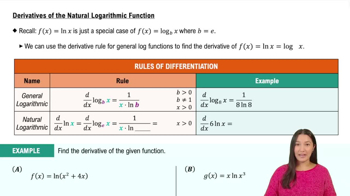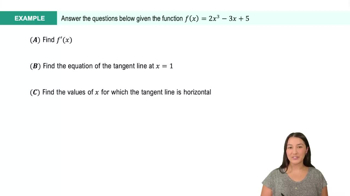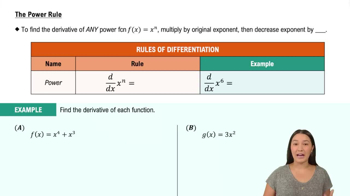Table of contents
- 0. Functions7h 52m
- Introduction to Functions16m
- Piecewise Functions10m
- Properties of Functions9m
- Common Functions1h 8m
- Transformations5m
- Combining Functions27m
- Exponent rules32m
- Exponential Functions28m
- Logarithmic Functions24m
- Properties of Logarithms34m
- Exponential & Logarithmic Equations35m
- Introduction to Trigonometric Functions38m
- Graphs of Trigonometric Functions44m
- Trigonometric Identities47m
- Inverse Trigonometric Functions48m
- 1. Limits and Continuity2h 2m
- 2. Intro to Derivatives1h 33m
- 3. Techniques of Differentiation3h 18m
- 4. Applications of Derivatives2h 38m
- 5. Graphical Applications of Derivatives6h 2m
- 6. Derivatives of Inverse, Exponential, & Logarithmic Functions2h 37m
- 7. Antiderivatives & Indefinite Integrals1h 26m
- 8. Definite Integrals4h 44m
- 9. Graphical Applications of Integrals2h 27m
- 10. Physics Applications of Integrals 2h 22m
3. Techniques of Differentiation
Basic Rules of Differentiation
Problem 3.9.5
Textbook Question
State the derivative rule for the logarithmic function f(x)=log(subscript b)x. How does it differ from the derivative formula for ln x?
 Verified step by step guidance
Verified step by step guidance1
The derivative of the logarithmic function \( f(x) = \log_b{x} \) is given by the formula \( f'(x) = \frac{1}{x \ln{b}} \). This formula is derived using the change of base formula for logarithms and the chain rule.
To understand this, recall the change of base formula: \( \log_b{x} = \frac{\ln{x}}{\ln{b}} \). This allows us to express the logarithm in terms of the natural logarithm, \( \ln{x} \).
Differentiate \( \frac{\ln{x}}{\ln{b}} \) with respect to \( x \). Since \( \ln{b} \) is a constant, the derivative is \( \frac{1}{\ln{b}} \cdot \frac{d}{dx}(\ln{x}) \).
The derivative of \( \ln{x} \) with respect to \( x \) is \( \frac{1}{x} \). Therefore, the derivative of \( \log_b{x} \) becomes \( \frac{1}{x \ln{b}} \).
In contrast, the derivative of \( \ln{x} \) is simply \( \frac{1}{x} \). The difference arises from the presence of the constant \( \ln{b} \) in the denominator for the derivative of \( \log_b{x} \).
 Verified video answer for a similar problem:
Verified video answer for a similar problem:This video solution was recommended by our tutors as helpful for the problem above
Video duration:
1mPlay a video:
Was this helpful?
Key Concepts
Here are the essential concepts you must grasp in order to answer the question correctly.
Derivative of Logarithmic Functions
The derivative of the logarithmic function f(x) = log_b(x) is given by f'(x) = 1 / (x ln(b)), where b is the base of the logarithm. This rule highlights how the derivative depends on both the input x and the natural logarithm of the base b, indicating that the rate of change of the logarithmic function varies with different bases.
Recommended video:

Derivative of the Natural Logarithmic Function
Natural Logarithm
The natural logarithm, denoted as ln(x), is a specific logarithmic function where the base is Euler's number e (approximately 2.718). The derivative of ln(x) is simpler, given by f'(x) = 1/x, which reflects the unique properties of the natural logarithm and its relationship to exponential functions.
Recommended video:

Derivative of the Natural Logarithmic Function
Comparison of Derivative Rules
The key difference between the derivatives of log_b(x) and ln(x) lies in the presence of the base b in the former's derivative formula. While ln(x) has a straightforward derivative of 1/x, log_b(x) introduces an additional factor of 1/ln(b), making it essential to consider the base when differentiating logarithmic functions with bases other than e.
Recommended video:
Guided course

Power Rules

 3:59m
3:59mWatch next
Master Derivatives of Linear Functions with a bite sized video explanation from Callie
Start learningRelated Videos
Related Practice







